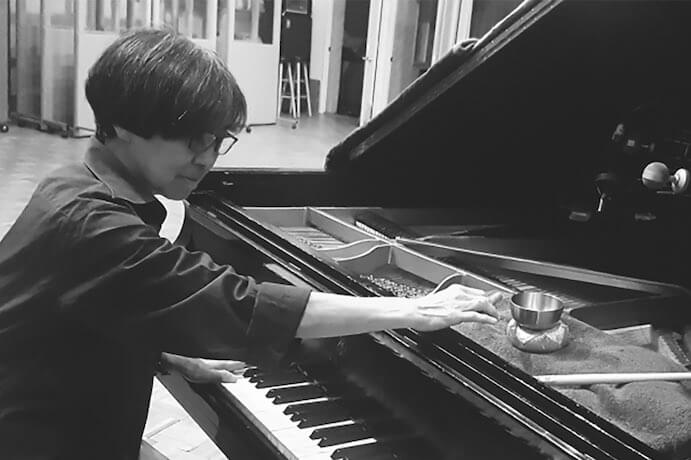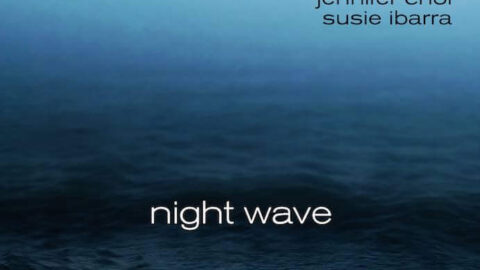Night Wave, Yuko Fujiyama’s first release on innova, is a must-hear for fans of both contemporary classical music and free jazz. Throughout the album’s 15 tracks, Fujiyama blends fully-composed textures with somewhat structured improvisations that sounds something like if Cecil Taylor met up with Arnold Schoenberg. In fact, in Fujiyama’s brief liner note to the album, she explains, “After encountering the music of pianist Cecil Taylor, I moved to New York in 1987 and started to perform in the early 1990s. Since then, I have been looking for the structure of music.”
The best part about Night Wave is how seamlessly it flows from composed material to improvisation–upon multiple listenings it can still be difficult discern which parts are which, a quality that speaks to both the overall strength of the compositions as well as the group dynamic as improvisers. In terms of singular tracks, Night Wave is full of highly complex structures. While all of the tracks are self-contained and highly developed in their own right, the sequencing and structure of the album as a whole doesn’t always work.
Night Wave’s opening track, the piano solo “Woven Colors,” is beautiful, evocative, and harmonically challenging, yet pleasing and easy to listen to. However, Night Wave as a whole is a record that is brimming with energy, and by the end of the album, “Woven Colors” is out of place, especially as an opener. It doesn’t set the tone for the rest of the album, especially when followed by what is easily the best track, “Up Tempo.” The tune is a kind of tour de force of free jazz rhythms and textures, all at blinding speed.
“Up Tempo” also features most welcome solos from percussionist Susie Ibarra and violinist Jennifer Choi. The two sound as if they can read Fujiyama’s every thought. The use of violin in jazz music can be a tricky road to cross. There are so many connotations associated with both the violin and jazz as a whole, that the violinist almost has to do extra work to keep up, but Choi is absolutely up to the challenge. She generally forgoes traditional melodic solos for a blend of extended techniques, sounding right at home with the percussive nature of Fujiyama’s playing. Ibarra meanwhile is just as comfortable keeping time as she is taking free time solos or creating textures of drones and whispers on the cymbals.
The playing of Graham Haynes on trumpet and flugelhorn, however, is a mixed bag. His playing doesn’t imply whether or not he wants to stick to more traditional means of jazz solos or experiment. Throughout the album, he gives the impression that he’s trying to keep up with the rest of the group. For example, “Fireworks” starts with short bursts of notes from Haynes, but he is quickly taken over by Fujiyama, Choi, and Ibarra, who between the three of them are able to make each new phrase sound like an entirely new instrument. Haynes goes silent for about 20 seconds before reappearing, but at that point, the rest of the ensemble has already created so many new textures that his playing no longer fits in. Of course, his role in the group could have been dictated by Fujiyama, but in execution, Haynes is out of place.
The song “Clash” is one of the standout performances from the group and sounds like a Fujiyama mission statement. Clocking in at just over a minute long, the track starts with a violin texture that wouldn’t be out of place in something by Bartok, but very quickly descends into frenzied madness from the entire ensemble. About 30 seconds into the composition, Ibarra’s playing sounds similar to keeping time in the jazz sense, but is punctuated with stops and starts and short bursts of energy. What could have been the “jazz section” of the piece becomes an extension of the chaos that preceded it. “Clash” represents both Fujiyama’s group at their very best and Fujiyama at her strongest compositionally.

While the blend of familiar textures from both jazz and contemporary classical music make Night Wave a must-hear for anyone interested in either genre, the packaging is something of a let down. The CD comes in a gatefold jacket meant for two discs, although only one is present. The artwork also leaves something to be desired–the music might have been better served by a visual image as daring as the sounds it accompanies. Art selection and packaging are an art unto themselves and often help to set the tone of the album, but on Night Wave, we see what looks like a stock photo of water. Generic photos of the band smiling are printed on the inside. The listener gets no indication from the packaging of how the music is going to sound, or what their experience should be. Even though potential budget constraints are always an important consideration, it still comes across as an afterthought.
Despite the few low points in Night Wave, overall it’s a fantastic release with enough moments of accessibility that those unfamiliar with free jazz and/or contemporary classical music can find something to love. But it’s also a bold and progressive release on which Fujiyama isn’t afraid to be very clear with her emotional intentions. With the relatively recent losses of both Ornette Coleman and Cecil Taylor, the world needs more adventurous blends of composition and improvisation like Fujiyama’s.
























